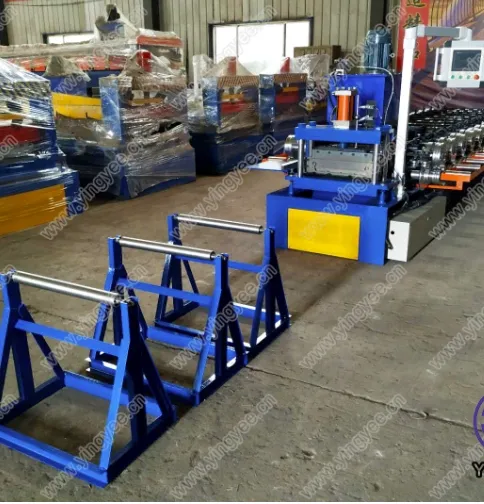
The architectural landscape is undergoing a silent revolution, driven by demand for structures that blend visual sophistication with uncompromising durability. Traditional roofing methods struggle to meet these dual mandates, often forcing compromises between aesthetic ambition and functional integrity. Enter the mihini tuitui tu: a technological marvel transforming coiled steel into architecturally striking, weather-tight roofing systems. These systems produce continuous panels with raised vertical seams that interlock mechanically, eliminating exposed fasteners while creating sleek, shadow-revealing profiles. For designers seeking to make bold statements with commercial builds or luxury residences, standing seam metal roof machines deliver unparalleled visual continuity and precision. This article explores how standing seam roll formers have become indispensable tools for creating iconic structures that marry avant-garde aesthetics with hurricane-grade resilience.

Standing seam machines have redefined architectural expression through precision-engineered panel fabrication. Raw steel coils feed into decoilers, then undergo cold-forming through sequential roller dies that shape metal into trapezoidal, double-lock, or snap-lock profiles without heat distortion. The absence of welding preserves metallic luster and factory coatings, ensuring decades of fade-resistant brilliance. Modern systems achieve 0.5mm seam alignment tolerances across 40-foot panels – a geometric perfection impossible with manual fabrication. This precision enables daring designs: museum roofs with 12:1 pitch slopes, cantilevered canopies with 20-foot unsupported spans, and undulating curved facades that shimmer under changing light. The mechanical seaming process creates water-shedding joints rated for 150 mph winds, while concealed clips allow thermal expansion without buckling. Architects now specify standing seam systems not just for roofs but as integrated façade elements, creating monolithic exteriors that turn buildings into landmarks.
A standing seam metal roof machine integrates specialized subsystems that transform raw materials into architectural components. Below are the core components of industrial-grade systems:
mihini tuitui tu Configuration
|
Component |
Quantity |
Functionality |
|
3 Ton Manual Decoiler |
1 Set |
Holds & feeds steel coils |
|
Main Roll Forming Unit |
1 Set |
Shapes seams via 16-24 roller stations |
|
Hydraulic Cutting System |
1 Set |
Precision panel trimming |
|
Hydraulic Power Station |
1 Set |
Drives cutting/forming pressure |
|
PLC Control System |
1 Set |
Automated length/speed programming |
|
Collection Table |
1 Set |
Supports finished panels |
|
Electric Lock Machine |
1 Set |
Forms mechanical seam interlocks |
|
Manual Edge Clamp |
2 Sets |
Secures panel alignment |
|
Curving Machine |
1 Set* |
Creates radial panel curves |
|
Obliquity Shear Machine |
1 Set* |
Cuts angled panel terminations |
Note: Curving machines and obliquity shears are optional for complex geometries. Contact suppliers for integration.
Standing seam roll formers liberate architects from geometric constraints through on-demand customization. Portable units deployed onsite fabricate panels to exact real-time measurements, accommodating last-minute design changes without project delays. Adjustable roller cassettes switch between profiles in 15 minutes – from 1.5-inch trapezoidal seams for industrial builds to slender ¾-inch snap-locks for residential elegance. Advanced models feature variable-pitch rollers that create tapered panels for conical towers or hyperbolic roofs. Material versatility expands creative possibilities: zinc panels develop patina-rich character over time, copper offers warm metallic hues, and PVDF-coated steel replicates weathered corten without corrosion. The cold-forming process preserves specialized coatings like cool-roof pigments that reduce urban heat island effects. For the Burj Al Arab’s sail-inspired roof, roll formers produced 3,500 unique curved panels with 0.1-degree bend accuracy – a feat unachievable with prefabricated systems.
Next-gen standing seam metal roof machines integrate IoT-enabled functionality for architectural innovation. BIM-compatible PLCs import 3D models to auto-generate panel profiles for complex geometries. Laser scanners verify seam dimensions every 0.8 seconds, adjusting rollers to maintain 0.3mm tolerances. Cloud-connected diagnostics predict bearing failures 300 operating hours before breakdowns. Sustainability features include energy-recovery drives and scrap-tracking algorithms achieving 99% material utilization. Solar integration is revolutionized: machines now form seams with pre-integrated PV mounting channels, eliminating roof penetrations. For the Shanghai Tower’s spiraling façade, AI-optimized roll formers produced 20,000 unique diamond-shaped panels with embedded drainage paths. As parametric design evolves, these machines will fabricate biophilic patterns and light-refracting textures impossible with current methods.
Precision tension control during roll forming maintains uniform metal stress distribution. Combined with trapezoidal stiffening ribs, this eliminates visible rippling across wide panels.
Yes. Ceramic-coated rollers prevent pigment damage during forming. UV-resistant PVDF coatings maintain chromatic integrity for 40+ years post-installation.
Daily roller cleaning with non-abrasive solutions and monthly gearbox lubrication. Hydraulic filters require quarterly replacement for peak cutting performance.
Optional curving attachments incrementally bend panels along programmable radii without creasing. Digital angle sensors ensure ±0.5° bend accuracy.
Absolutely. 100% steel content commands premium scrap value. Zinc/aluminum variants are infinitely recyclable without quality degradation.